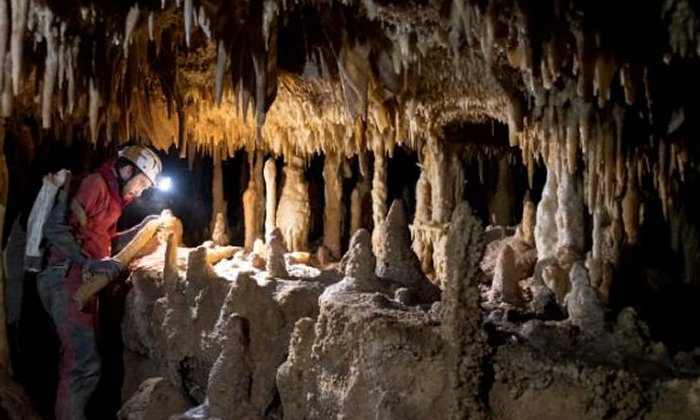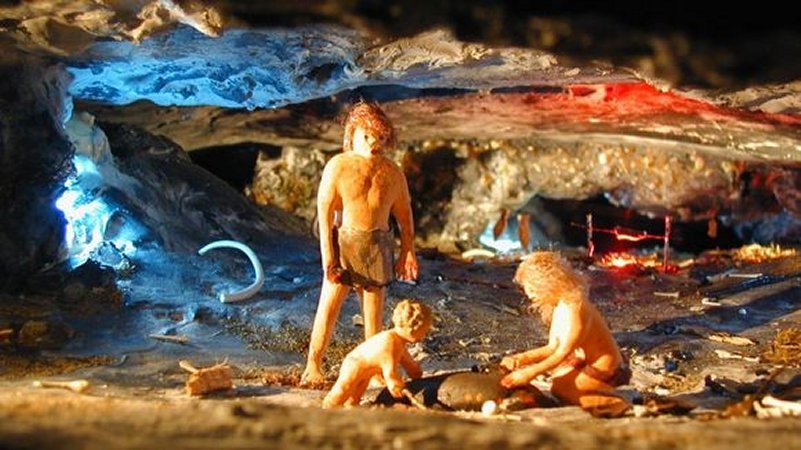Neanderthals Of The Mediterranean Areas Became Extinct But Not Because Of Climate
Conny Waters - AncientPages.com - Homo Neanderthaliensis did not become extinct because of changes in climate. At least, this did not happen to the several Neanderthals groups that lived in the western Mediterranean 42,000 years ago.
 Researchers sampled this 50-cm long stalagmite in the Pozzo Cucù cave, in the Castellana Grotte area (Bari) and they carried out 27 high-precision datings and 2,700 analyses of carbon and oxygen stable isotopes. Photo: O. Lacarbonara
Researchers sampled this 50-cm long stalagmite in the Pozzo Cucù cave, in the Castellana Grotte area (Bari) and they carried out 27 high-precision datings and 2,700 analyses of carbon and oxygen stable isotopes. Photo: O. Lacarbonara
The researchers from the University of Bologna analyzed stalagmite samples from some caves on the Murge karst plateau in Apulia, Italy, where Neanderthals and Homo Sapiens coexisted there for at least 3,000 years, from approximately 45,000 to 42,000 years ago.
"Our study shows that this area of Apulia appears as a 'climate niche' during the transition from Neanderthals to Homo Sapiens" explains Andrea Columbu, researcher and first author of this study said in a press release.
"It doesn't seem possible that significant climate changes happened during that period, at least not impactful enough to cause the extinction of Neanderthals in Apulia and, by the same token, in similar areas of the Mediterranean".
It is said that a changing climate was a factor in Neanderthals extinction (that happened, in Europe, nearly 42,000 years ago). A new study confirms these sharp climate changes regarding continental Europe, but not in some Mediterranean areas where Neanderthals had lived since 100,000 years ago.
"Apulia is key to our understanding of anthropological movements: we know that both Neanderthals and Homo Sapiens lived there approximately 45,000 years ago", says Andrea Columbu.
"Very few other areas in the world saw both species co-existing in a relatively small space. This makes the Murge plateau the perfect place to study the climate and the bio-cultural grounds of the transition from Neanderthal to Sapiens".
A climate reconstruction of such a remote period can be provided with the help of stalagmites, rising from the floor of karst caves thanks to ceiling water drippings.
"Stalagmites are excellent paleoclimatic and paleoenvironmental archives", explains Jo De Waele, research coordinator and professor at the University of Bologna.

Researchers found out that Apulian stalagmites showed a consistent pace of dripping in the last and previous ice ages. This means that no abrupt change in climate happened during the millennia under investigation. A draught would have been visible in the stalagmites.
Among all the stalagmites that were analyzed, one was particularly relevant. Researchers sampled this 50-cm long stalagmite in the Pozzo Cucù cave, in the Castellana Grotte area (Bari) and they carried out 27 high-precision datings and 2,700 analyses of carbon and oxygen stable isotopes. According to dating, this stalagmite formed between 106,000 and 27,000 years ago. This stalagmite represents the longest timeline of the last ice age in the western Mediterranean and in Europe. Moreover, this stalagmite did not show any trace of abrupt changes in climate that might have caused Neanderthals' extinction.
"The analyses we carried out show little variation in rainfall between 50,000 and 27,000 years ago, the extent of this variation is not enough to cause alterations in the flora inhabiting the environment above the cave", says Jo De Waele. "Carbon isotopes show that the bio-productivity of the soil remained all in all consistent during this period that includes the 3,000 years-long coexistence between Sapiens and Neanderthals. This means that significant changes in flora and thus in climate did not happen".
The results seem to show that the dramatic changes in the climate of the last ice age had a different impact on the Mediterranean area than in continental Europe and Greenland. This may rule out the hypothesis that climate changes are responsible for Neanderthals dying out.
How do we explain their extinction after a few millennia of coexistence with Homo Sapiens?
"The results we obtained corroborate the hypothesis, put forward by many scholars, that the extinction of Neanderthals had to do with technology", says Stefano Benazzi, a paleontologist at the University of Bologna and one of the authors of the paper.
"According to this hypothesis, the Homo Sapiens hunted using a technology that was far more advanced than Neanderthals', and this represented a primary reason to Sapiens' supremacy over Neanderthals, that eventually became extinct after 3,000 years of co-existence".
Written by Conny Waters - AncientPages.com Staff Writer




















